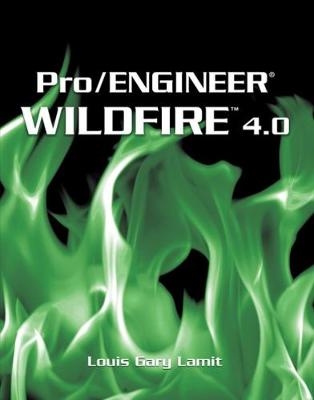
Pro/ENGINEER® Wildfire™ 4.0
CL Engineering (Verlag)
978-0-495-41119-2 (ISBN)
- Titel z.Zt. nicht lieferbar
- Versandkostenfrei innerhalb Deutschlands
- Auch auf Rechnung
- Verfügbarkeit in der Filiale vor Ort prüfen
- Artikel merken
Pro/Engineer Wildfire 4.0 is one of the most widely used CAD/CAM software programs in the world today. Designed for a one or two semester undergraduate course for first or second year engineering students, Pro/engineer Wildfire 4.0 is an extremely beneficial book for both aspiring and newly employed engineers. The text involves creating a new part, an assembly, or drawing, using a set of Pro/E commands, walking you through the process systematically and guiding you through parametric design. While using this text, a student will create individual parts, assemblies, and drawings.
Louis Gary Lamit is the former head of the drafting department and CAD facility manager, and is currently an instructor at De Anza College in Cupertino, California, where he teaches computer-aided design. Mr. Lamit has worked as a drafter, designer, numerical control (NC) programmer, technical illustrator, and engineer in the automotive, aircraft, and piping industries. A majority of his work experience is in the area of mechanical and piping design. He started as a drafter in Detroit (as a job shopper) in the automobile industry, doing tooling, dies, jigs and fixture layout, and detailing at Koltenbar Engineering, Tool Engineering, Time Engineering, and Premier Engineering for Chrysler, Ford, AMC, and Fisher Body. Mr. Lamit has worked at Remington Arms and Pratt and Whitney Aircraft as a designer, and at Boeing Aircraft and Kollmorgan Optics as an NC programmer and aircraft engineer. Mr. Lamit also owns and operates his own consulting firm, and has been involved with advertising and patent illustrating.
Introduction
Parametric Design
Fundamentals
Part Design
Establishing Features
Datum Features
Parent-Child Relationships
Capturing Design Intent
Assemblies
Drawings
Using the Text
Text 18
Lesson 1 - Pro/ENGINEER Wildfire 3.0 Overview
Creating the Pin Part
Creating the Plate Part
Creating the Assembly
Creating Drawings
Lesson 2 - Pro/ENGINEER Wildfire 3.0
Pro/ENGINEERs Main Window
Catalog Parts
ProductView Lite
File Functions
Help
View and Display Functions
Using Mouse Buttons to Manipulate the Model
System Display Settings
Information Tools
The Model Tree
Working on the Model
About the Dashboard
Lesson 3 - Direct Modeling
Modeling
Extrude Tool
Round Tool
Shell Tool
Draft Tool
Chamfer Tool
Hole Tool
Extrude Tool (Cut)
Mirror Sketch
Revolve Tool
Cross Sections
Revolve Tool (Cut)
Lesson 4 - Extrusions
The Design Process
Material Files
Sketch Tool
Environment
Constraints
Sketching
Dimensioning
Modifying Dimensions
Lesson 5 - Datums, Layers, and Sections
Navigator
Colors
Appearance Editor
Datum Plane Tool
Layers
Geometric Tolerances
Hole Tool (Sketched)
Suppressing and Resuming Features
Cross Sections
View Manager
Relations
Info
Feature List
Lesson 6 - Revolved Features
Revolve Tool
Chamfers
Threads
Standard Holes
Navigation Window
Manipulating Folders
Folder Browser
Model Tree
Holes
Dimension Properties
Materials
Cosmetic Threads
Using the Model Player
Printing and Plotting
Lesson 7 - Feature Operations
Ribs
Relations
Parameter Symbols
Operators and Functions
Arithmetic Operators
Assignment Operators
Comparison Operators
Mathematical Functions
Failed Features
Family Tables
Copy
Paste Special
Rib Tool
Flexing the Model
Measuring Geometry
Standard Holes
Family Tables
Pro/MANUFACTURING
Lesson 8 - Assemblies
Assembly Constraints
Placing Components
Pro/Library
Catalog Parts
Layer Tree
Add a Component to the Assembly
Regenerating Models
Copy and Paste Components
Bill of Materials
Assembly Sections
Creating Components in the Assembly Mode
Top-Down Design
Global Reference Viewer
Pattern
Analysis
Interference
Rotating Components
Component Operations
Bill of Materials
Edit Definition
Edit
Lesson 9 - Exploded Assemblies and View Manager
Creating Exploded Views
Component Display
Types of Representations
View Manager
URLs and Model Notes
Views: Perspective, Saved, and Exploded
Saved Views
Default Exploded Views
View Manager
Explode View
View Style
Model Tree
Lesson 10 - Introduction to Drawings
Formats, Title Blocks, and Views
Specifying the Format Size
Standard Formats
Drawing Templates
Template View
Views
Page Setup
System Formats
Show/Erase
Cleanup Dimensions
Move Views
Delete Views
Dimension Options
Drawing Scale
Section Views
Drawing View Properties
Lesson 11 - Part Drawings -
Page Setup
Drawing Options
Drawing Options File
Drawing Views
Auxiliary Views
Section Views
Show/Erase Drawing Items
Detail Views
Dimension Properties
Text Style
Geometric Tolerances
Pictorial Drawing Views
Title Block Notes
Drawing View Information
Lesson 12 - Assembly Drawings
Format Options
Format Notes
Tables
Text Style
Report Symbols
Adding Parts List Data
Parameters
Relations
Assembly Drawings
Bill of Materials
Assembly Drawing Views
Assembly Section
BOM Balloons
Exploded Assembly Drawings
Lesson 13 - Patterns
Fill Pattern
Axial Pattern
Copy and Paste Special
Group
Insert Mode
Scale Model
Sheetmetal
Flat Walls
Flange Walls
Directional Pattern
Flat Pattern
Lesson 14 - Blends
Blend Options
Parallel Blends
Rotational and General Blends
Blend Tool
Polar Grid
Axial Pattern
Analysis Measure
Section
Lesson 15 - Sweeps
Sweep Forms
Sweep Options
Sweep Tool
Trajectory
Lesson 16 - Helical Sweeps and 3D Model Notes
Helical Sweeps
3D Model Notes
Helical Compression Spring
Helical Sweep Tool
Model Notes
URL Links
Springs
Lesson 17 - Shell, Reorder, and Insert Mode
Creating Shells
Reordering Features
Inserting Features
Draft Tool
Shell Tool
Pattern Table
Reorder
Insert Mode
Lesson 18 - Drafts, Suppress, and Text Extrusions
Drafts
Suppressing and Resuming Features
Text Extrusions
Draft Tool
Shell Tool
Group
Mirror
Surface Round
Section
View Manager
Solidify Tool
Suppress
Extrude Tool
Resume
ModelCHECK Geometry Check
Appendix
Customizing the User Interface (UI)
Customize Screen
Navigation
Browser
Mapkeys
Record Mapkeys
Customize Mapkeys
Quick Reference Cards
Index
| Sprache | englisch |
|---|---|
| Maße | 215 x 274 mm |
| Gewicht | 1381 g |
| Themenwelt | Informatik ► Weitere Themen ► CAD-Programme |
| Technik ► Maschinenbau | |
| ISBN-10 | 0-495-41119-1 / 0495411191 |
| ISBN-13 | 978-0-495-41119-2 / 9780495411192 |
| Zustand | Neuware |
| Haben Sie eine Frage zum Produkt? |
aus dem Bereich


